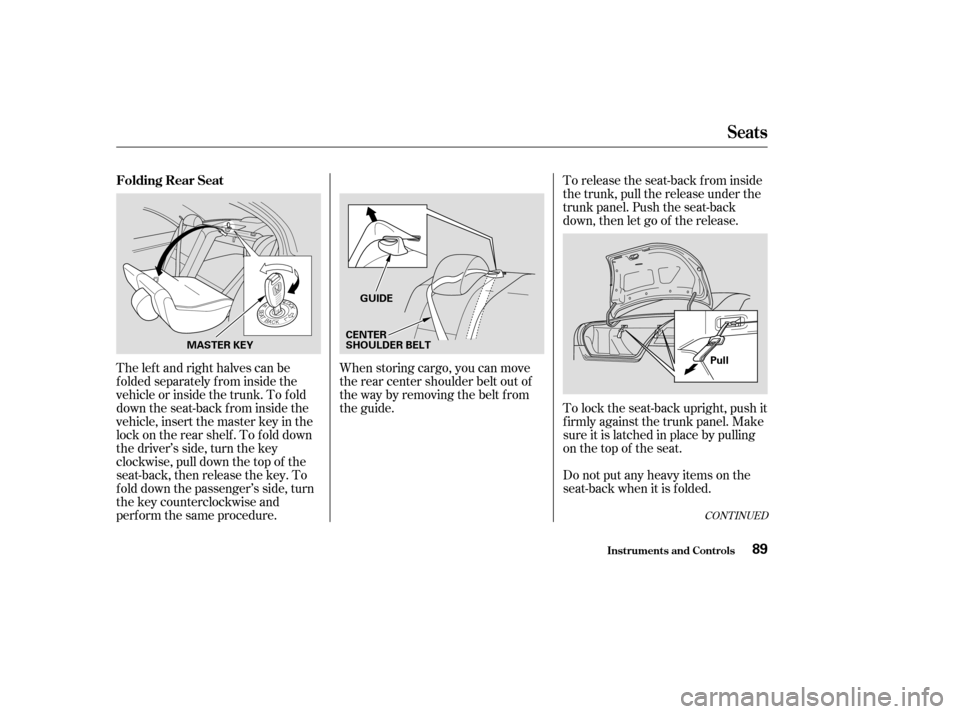Page 47 of 313

A child who has outgrown a forward-
f acing child seat should ride in the
back seat and use a booster seat
until the lap/shoulder belt f its them
properly without the booster.
Some states also require children to
use a booster until they reach a
given age or weight (e.g., 6 years or
60lbs).Besuretocheckcurrent
laws in the state or states where you
intend to drive.The National Highway Traffic Safety
Administration and Transport
Canada recommend that all children
ages 12 and under be properly
restrained in the back seat.
Even with advanced front airbag, the
back seat is the safest place for a
child of any age or size.
If the passenger’s f ront airbag is on,
and it inflates in a moderate to
severe f rontal collision, the airbag
can cause serious injuries to a child
who is unrestrained, improperly
restrained, sitting too close to the
airbag, or out of position.
The side airbag also poses risks. If
any part of a larger child’s body is in
the path of a deploying side airbag,
the child could receive possibly
serious injuries.
Booster seats can be high-back or
low-back. Whichever style you select,
make sure the booster meets f ederal
saf ety standards (see page ) and
that you f ollow the booster seat
maker’s instructions.
If a child who uses a booster must
ride in f ront, move the vehicle seat
as far to the rear as possible, and be
sure the child is wearing the seat
belt properly.
A child may continue using a booster
seat until the tops of their ears are
even with the top of the vehicle’s or
booster’s seat-back. A child of this
height should be tall enough to use
the lap/shoulder belt without a
booster.
40
Protecting L arger Children
Driver and Passenger Saf ety
Using a Booster Seat
When Can a L arger Child Sit in
Front
48
�����—�����—�����y�
�������������y���
�(���%���
���y�������
�y
Page 48 of 313

Of course, children vary widely. And
while age may be one indicator of
when a child can saf ely ride in f ront.
There are other important f actors
youshouldconsider.If you decide that a child can saf ely
ride up f ront, be sure to:
Caref ully read the owner’s manual
and make sure you understand all
seat belt instructions and all saf ety
inf ormation.
Move the vehicle seat to the rear-
most position.
Have the child sit up straight, back
against the seat, and feet on or
near the f loor.
Check that the child’s seat belt is
properly and securely positioned.
Supervise the child. Even mature
children sometimes need to be
reminded to f asten the seat belts
or sit properly.
To saf ely ride in f ront, a child must
be able to f ollow the rules, including
sitting properly, and wearing the seat
belt properly throughout a ride.
Physically, a child must be large
enough f or the lap/shoulder belt to
properly f it (see pages and ). If
the seat belt does not f it properly,
with or without the child sitting on a
booster, the child should not sit in
front.
14 47
CONT INUED
Protecting L arger Children
Driver and Passenger Saf ety
Maturity
Physical Size
49
�����—�����—�����y�
�������������y���
�(���%���
���y���������y
Page 49 of 313
This could result
in serious neck injuries during a
crash. Devices intended to
improve a child’s comf ort or
reposition the shoulder part of a
seat belt can make the belt less
effective, and increase the chance
of serious injury in a crash.
This could
cause very serious injuries during
a crash. It also increases the
chance that the child will slide
under the belt in a crash and be
injured.
If they do, they
could be very seriously injured in a
crash.
Protecting L arger Children
Driver and Passenger Saf ety
Do not let a child wear a seat belt
across t he neck. Do not put any accessories on a
seat belt .
Do not let a child put the shoulder part of a seat belt behind t he back
or under t he arm.
T wo children should never use t hesame seat belt .
Additional Saf ety Precautions
50
�����—�����—�����y�
���������
���y���
�(���%���
���y���������y
Page 56 of 313
�Î
�Î
The U.S. instrument panel is shown. Dif f erences f or the Canadian models are noted in the text.
Instrument Panel
Inst rument s and Cont rols57
LOW FUEL INDICATORMAINTENANCE REQUIRED
INDICATOR
HIGH BEAM INDICATOR
CRUISE MAIN INDICATOR ANTI-LOCK BRAKE SYSTEM
INDICATOR
LOW OIL PRESSURE
INDICATOR
CHARGING SYSTEM
INDICATOR
SECURITY SYSTEM INDICATORSUPPLEMENTAL
RESTRAINT SYSTEM
INDICATOR
TCS ACTIVATION INDICATOR
CRUISE CONTROL INDICATOR
DOOR AND TRUNK
OPEN MONITOR
LIGHTS ON INDICATOR
PARKING BRAKE AND BRAKE
SYSTEM INDICATOR TRACTION CONTROL SYSTEM (TCS)
INDICATOR
MALFUNCTION INDICATOR LAMP IMMOBILIZER SYSTEM INDICATOR
(P.58, 269) (P.58, 268) (P.60)
(P.63)
(P.63) (P.60)
(P.63)
(P.60) (P.61)
(P.63) (P.61)
(P.59)
(P.59)
(P.62, 155) (P.62)
SEAT BELT REMINDER INDICATOR (P.58)
(P.62)
(P.59)
(P.269) SIDE AIRBAG OFF
INDICATOR
�����—�����—�����y�
����
��������y���
�(���%���
���y���������y
Page 57 of 313

The instrument panel has many
indicators to give you important
inf ormation about your vehicle.The engine can be severely damaged
if this indicator f lashes or stays on
when the engine is running. For
more inf ormation, see page .
If this indicator comes on when the
engine is running, the battery is not
being charged. For more inf ormation,
see page .
See page .
The seat belt system includes an
indicator on the instrument panel
and a beeper to remind you and your
passengers to f asten your seat belts.
If you turn the ignition switch to ON
(II) bef ore f astening your seat belt,
the beeper sounds and the indicator
f lashes. If you do not f asten your
seat belt bef ore the beeper stops, the
indicator stops f lashing but remainson.
If you continue driving without
f astening your seat belt, the beeper
sounds and the indicator f lashes
again at regular intervals.
268
269 269
Instrument Panel Indicators
Inst rument s and Cont rols
Seat Belt Reminder
Indicator L ow Oil Pressure
Indicator
Charging System
Indicator
Malf unction Indicator
Lamp
58
�����—�����—�����y�
����
��������y���
�(���%���
���y�������
�y
Page 58 of 313

This indicator has two f unctions:This indicator comes on when you
turn the ignition switch to ON (II).
It is a reminder to check the
parking brake. If you drive at
certain speeds without f ully
releasing the parking brake, the
beeper sounds continuously.
Driving with the parking brake not
fully released can damage the
brakes and tires. This indicator lights brief ly when
you turn the ignition switch to ON
(II). If it comes on at any other time,
it indicates a potential problem with
your f ront airbags. This indicator will
also alert you to a potential problem
with your side airbags, passenger’s
side airbag automatic cutoff system,
side curtain airbags, automatic seat
belt tensioners, driver’s seat position
sensor, or f ront passenger’s weight
sensors. For more inf ormation, see
page .
This indicator comes on when you
turn the ignition switch to ON (II). If
it comes on at any other time, it
indicates that the passenger’s side
airbag has automatically shut off.
For more inf ormation, see page .
If it remains lit af ter you f ully
release the parking brake while
the engine is running, or if it
comes on while driving, there
could be a problem with the brake
system. For more inf ormation, see
page .
1. 2.
271 27
28
Only on models equipped with side
airbags
Instrument Panel Indicators
Inst rument s and Cont rols
Parking Brake and Brake System
Indicator Supplemental Restraint
System Indicator
Side Airbag Of f Indicator
59
U.S. Canada
�����—�����—�����y�
����
�
������y���
�(���%���
���y���������y
Page 88 of 313

CONT INUED
When storing cargo, you can move
therearcentershoulderbeltoutof
the way by removing the belt f rom
the guide.Do not put any heavy items on the
seat-back when it is folded.
The left and right halves can be
f olded separately f rom inside the
vehicle or inside the trunk. To f old
down the seat-back f rom inside the
vehicle, insert the master key in the
lock on the rear shelf . To f old down
the driver’s side, turn the key
clockwise, pull down the top of the
seat-back, then release the key. To
f old down the passenger’s side, turn
the key counterclockwise and
perf orm the same procedure. To release the seat-back from inside
the trunk, pull the release under the
trunk panel. Push the seat-back
down, then let go of the release.
To lock the seat-back upright, push it
firmly against the trunk panel. Make
sure it is latched in place by pulling
on the top of the seat.
Seats
Inst rument s and Cont rols
Folding Rear Seat
89
GUIDE
Pull
CENTER
SHOULDER BELT
MASTER KEY
�����—�����—�����y�
����
��������y���
�(���%���
���y���������y
Page 89 of 313

Both f ront seats are equipped with
seat heaters. Because of the sensors
f or the side airbag system, there is
no heater in the passenger’s seat-
back. The ignition switch must be
ON (II) to use the heaters.
Make sure all rear shoulder belts are
positioned in f ront of the rear seat-
back whenever the seat-back is in its
upright position.
Make sure all items in the trunk, or
items extending through the opening
into the back seat, are secured.
Looseitemscanflyforwardand
cause injury if you have to brake
hard. See on page
.
Never drive with the seat-back
f olded down and the trunk lid open.
See on
page .
Push the front of the switch, HI, to
rapidly heat up the seat. Af ter the
seat reaches a comfortable
temperature, select LO by pushingthe back of the switch. This will keep
the seat warm.
In HI, the heater turns of f when the
seat gets warm, and turns back on
after the seat’s temperature drops.
In LO, the heater runs continuously.
It does not cycle with temperature
changes.
Follow these precautions when using
the seat heaters:
Use the HI setting only to heat the
seats quickly, because it draws
large amounts of current f rom the
battery.
If the engine is lef t idling f or an
extended period, do not use the
seat heaters, even on the LO
setting. It can weaken the battery,
causing hard starting.
173
51
On EX-V6 model and EX-L model
Seat Heaters
Carrying Cargo
Carbon Monoxide Hazard
Seats, Seat Heaters
Inst rument s and Cont rols90
SEAT HEATER
SWITCH
�����—�����—�����y�
����
��������y���
�(���%���
���y���������y